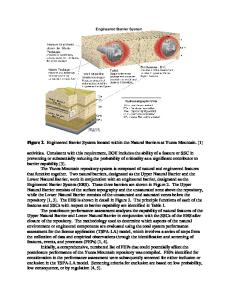Lessons Learned from the Yucca Mountain Nuclear Waste Repository Project The Engineered Barrier System
- PDF / 208,278 Bytes
- 9 Pages / 432 x 648 pts Page_size
- 64 Downloads / 321 Views
Lessons Learned from the Yucca Mountain Nuclear Waste Repository Project The Engineered Barrier System D. J. Duquette,1 C. A. W. Di Bella,2 R. M. Latanision,2 and B. E. Kirstein2 1 2
Rensselaer Polytechnic Institute, Troy, NY, 12180-3590 U.S. Nuclear Waste Technical Review Board, 2300 Clarendon Blvd., Arlington, VA 222013367
ABSTRACT Nuclear waste isolation programs both inside and outside the United States have provided evidence that there are many geologic options for a repository, but virtually all of them rely to some degree on an engineered barrier system (EBS) to isolate and/or retard the migration of radionuclides to the biosphere. At Yucca Mountain, the design of the EBS was unexpectedly challenging because of uncertainties in quantitatively determining the local environment of the EBS particularly during the thermal pulse. The EBS design for the Yucca Mountain site evolved from a thin-walled, limited-lifetime, corrosion-resistant canister through a corrosion-allowance canister, to the present design, which may have a lifetime of more than 106 years. The EBS proposed for the Yucca Mountain repository has many individual sub-barriers, beginning with the spent fuel and waste, the cladding of the spent fuel, the geometry of the package, etc. The anticipated modes of degradation of engineering materials, including corrosion of the fuel, of the canister, and of the drip shield proposed specifically for the Yucca Mountain project, and the consequences of the materials degradation on the performance of the repository are presented. The roles of conservative modeling and simplifying assumptions for radionuclide mobilization and transport in the EBS on characterization of the source term are addressed. THE YUCCA MOUNTAIN ENGINEERED BARRIER SYSTEM (EBS) In the mid-1980’s the US Department of Energy’s (USDOE) Office of Civilian Radioactive Waste Management was investigating three potential repository sites for disposal of spent nuclear fuel (SNF) and high level waste (HLW): a bedded salt site in Deaf Smith County, Texas; a basalt site at Hanford, Washington; and a tuff site at Yucca Mountain in Nevada. Because the emphasis was on obtaining geologic data for comparing the three sites, relatively little attention was paid to the waste package that could be used at any of the candidate sites. With the selection of the tuff site at Yucca Mountain, a conceptual EBS system was designed. The original design called for a thin walled stainless-steel waste package that would have a limited life. The Nuclear Regulatory Commission regulations in effect for repositories at the time appeared to limit the credit that could be taken for the waste packages to no more than 1,000 years-the approximate maximum duration of the thermal pulse. 1
1
The thermal pulse is the period when waste package surface temperatures are substantially above ambient at repository depth. For Yucca Mountain, the thermal pulse begins when the repository is closed and lasts until waste package surface temperatures drop below 96°C. The duration of the thermal
Data Loading...











